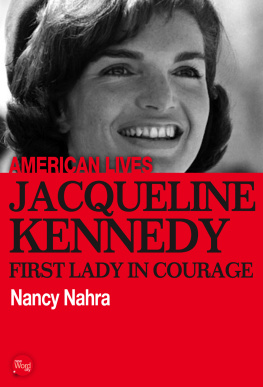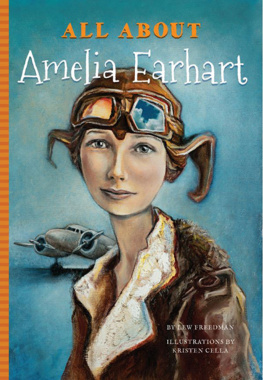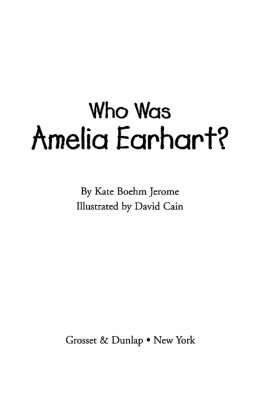When she took off on her epic flight around the world on June 1, 1937, Amelia Earhart had already earned her place in twentieth-century history. She was the first woman (and second person) to fly solo over the Atlantic Ocean. She set more than a dozen records in the hazardous early days of aviation: She was the first pilot to fly nonstop across the continental United States and the first to fly from Honolulu to California.
Despite those accomplishments, she remained modest, self-effacing, and charming, counting mechanics, rival pilots, and First Lady Eleanor Roosevelt among her close friends. But our enduring fascination with her stems largely from the mystery of her final flight. When Earhart and her navigator, Fred Noonan, vanished into the vastness of the Pacific Ocean more than seventy-five years ago, President Franklin D. Roosevelt immediately ordered a search that lasted seventeen days and cost $4 million.
That was only the first of dozens of attempts to find out what had happened to Earhart and her plane. The mystery has given rise to wild legends and conjectures - for example, some maintain that she and Noonan were captured and executed as spies by the Japanese. Its a search that never ends.
Earharts disappearance has come to overshadow her life, but she was more much more. Heres her story with lessons for leaders everywhere.
A Turbulent Takeoff
Though Amelia Earharts name is firmly linked with aviation, she was born in 1897, when Queen Victoria was still on the throne and human flight unknown. Earharts birthplace, Atchison, Kansas, however, was not without notoriety, having gained fame as the last stop for stagecoaches headed east from the still Wild West. Bringing the railroad to this Kansas town was just one of the triumphs of Earharts grandfather, Alfred Gideon Otis, a former federal judge and the patriarch of one of the three families that ran Atchison.
Otis had started the local bank, the railroad line, and the gas company, all buffing his ever-growing wealth and social standing. His daughter Amy, Amelias mother, was a retiring and intellectual sort compared to other family members. Amy distinguished herself by starting the local Dickens society, and she foreshadowed her daughters quest for records by becoming the first woman to reach the summit of Pikes Peak. Also like her daughter, Amy shrugged off her triumph, explaining matter-of-factly that she just liked to finish what she started.
Amy had dreamed of going to Vassar, but the judge put his foot down: By his lights, women should not work outside the home and thus had no need to go to college. He valued education highly but only for men. His daughter had her way, however, when she chose her husband. And because the judge so rarely faced a challenge, he never recovered from Amys rebellious act. Against her strictly Episcopalian parents wishes, Amy married Edwin Earhart, a German Lutheran from out of town. Even though Edwins ancestors had fought alongside George Washington and his father had been an industrious and respected missionary, none of it carried weight with Otis. The in-laws were still Lutherans.
A Brilliant Father
Except for Alfred Otis, anyone who met Edwin Earhart easily could see why Amy married him. True, he was not as wealthy as the Otises, but nor were most people. Without exaggeration, Edwin could be called brilliant. After four years of study, he graduated at age eighteen from Thiel College, a Lutheran school in Pennsylvania. No other Thiel graduate ever matched his accomplishment.
Edwin went on to study law at Yale where he met classmate Mark Otis, Amys brother. Mark invited Edwin to attend Amys coming-out party in Atchison. She was charmed, and, in time she fell in love with the tall, witty man with the winning smile. Everyone other than Judge Otis agreed that Edwin was destined for greatness. The judge remained obdurate when Amy insisted on pursuing the relationship, and still wouldnt give in when Edwin converted to the Episcopal faith. Amys parents did not attend their daughters wedding, a small affair given the weight of the judges disapproval.
Amelia Mary Earhart was born on July 24, 1897. Her sister Muriel arrived three years later. Amelia adapted quickly to the role of elder sister. She taught the neighborhood children, including her many cousins, how to ride a bicycle and play games she invented. Nicknamed Millie, she was a natural leader, and Muriel known as Pidge - was among her dutiful followers.
Peppy and imaginative, Amelia loved the outdoors, running and doing what the boys did - climbing fences, shooting rats with a .22 rifle, and taking running starts instead of waiting for a gentle push at the top of the local sledding hill. Amy aided and abetted her daughters by outfitting them in bloomers rather than skirts. The judge, of course, harrumphed gravely.
At age seven, Amelia saw a roller coaster on a trip to St. Louis, but she wasnt allowed to take a ride. Back home, she and her uncle Mark constructed a track made of two-by-fours running down from the roof of a tool shed. Amelia rolled down the track in a wooden box outfitted with roller-skate wheels. She emerged from the wreckage with a torn dress, a bruised lip, and what she later described as a sense of exhilaration. Oh, Pidge, she exulted, its just like flying!
Three years later, however, when Amelia saw her first airplane at a state fair and her father offered to let her ride in it, she opted for the merry-go-round instead. Later, she said the rickety old biplane was a thing of rusty wires and wood and not at all interesting.
A Two-Room School
Amelias grandfather Otis was right on one front: Attorney Edwin Earhart wasnt living up to his potential. He took a low-level job handling damage claims for the Rock Island Railroad. When the railroad transferred him to Des Moines, Iowa, Edwin and Amy left their daughters with her parents.
Amelia, who had learned to read at the age of five, spent hours in her grandparents library. She got early home schooling from her mother and was sent to a tiny private school pretentiously called The College Preparatory School. Operating in a former stable, the school had about thirty students in classes going up to grade twelve. There was just one teacher. Amelia loved it - most of the time.
By 1907, when Amelia was in the fifth grade, Edwin Earharts prospects had improved. He could afford better quarters and even two servants, allowing Muriel to join her parents in Des Moines. But Amelia stayed behind with her grandparents in Atchison, where events had taken a turn for the worse. Whether the judge suffered a minor stroke or some sort of nervous breakdown, he turned inward and remote. His wife, deprived of his companionship, was lonely, prompting the family to leave the intelligent and lively Amelia in Atchison to provide company for her grandmother.
Living in the elegant home where her mother had been born, with its view of the Missouri River, stock of books, opportunities for privacy, and the love of her grandmother enabled Amelia to flourish as a thoughtful and inquisitive girl with a mind of her own.
But Amelias grandmother didnt understand her granddaughters taste for adventure. More than once during Amelias grade-school years, Mrs. Otis explained to her granddaughter that when she was a girl back in Philadelphia, the most vigorous activity she ever undertook was to roll her hoop in the park. Amelia was unimpressed.
We Girls Would Like to Play
Like most schools at the time, College Preparatory had a sports program that excluded girls. It was all but universally accepted that girls were delicate and had to be protected from rough play and danger of any kind. Girls could participate only as cheerleaders for the schools teams.
Predictably, Amelia Earhart scoffed at that notion, especially since the school had so few students and needed all the athletes it could get. So she rounded up other girls who wanted to play sports, not just watch them, then she told the captain of the basketball team, We girls would like to play. Thinking that no girl had probably ever asked before, it didnt occur to Amelia that she would be denied permission. But she was a half-century ahead of her time and could only fume when the school refused.
Next page









